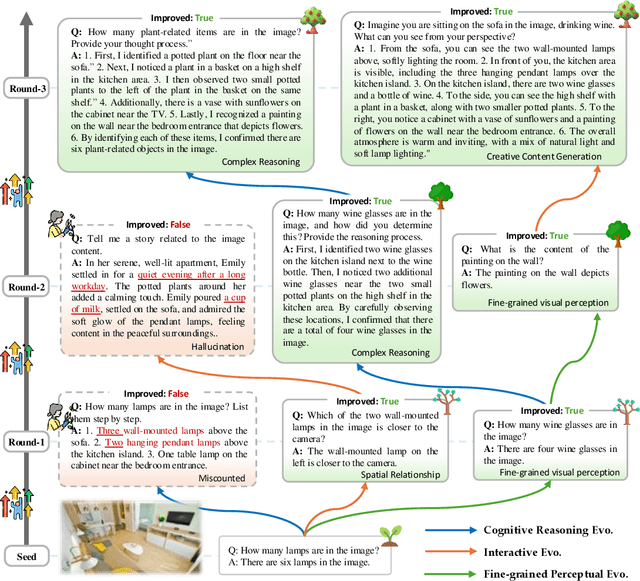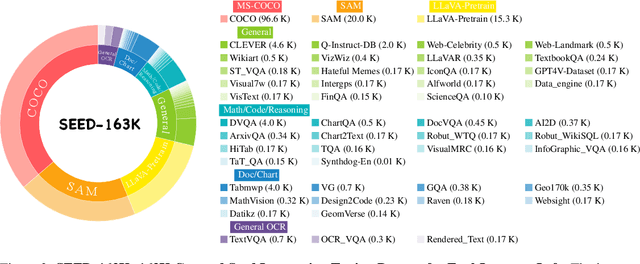Heng Tao Shen
Syzygy of Thoughts: Improving LLM CoT with the Minimal Free Resolution
Apr 16, 2025Abstract:Chain-of-Thought (CoT) prompting enhances the reasoning of large language models (LLMs) by decomposing problems into sequential steps, mimicking human logic and reducing errors. However, complex tasks with vast solution spaces and vague constraints often exceed the capacity of a single reasoning chain. Inspired by Minimal Free Resolution (MFR) in commutative algebra and algebraic geometry, we propose Syzygy of Thoughts (SoT)-a novel framework that extends CoT by introducing auxiliary, interrelated reasoning paths. SoT captures deeper logical dependencies, enabling more robust and structured problem-solving. MFR decomposes a module into a sequence of free modules with minimal rank, providing a structured analytical approach to complex systems. This method introduces the concepts of "Module", "Betti numbers","Freeness", "Mapping", "Exactness" and "Minimality", enabling the systematic decomposition of the original complex problem into logically complete minimal subproblems while preserving key problem features and reducing reasoning length. We tested SoT across diverse datasets (e.g., GSM8K, MATH) and models (e.g., GPT-4o-mini, Qwen2.5), achieving inference accuracy that matches or surpasses mainstream CoTs standards. Additionally, by aligning the sampling process with algebraic constraints, our approach enhances the scalability of inference time in LLMs, ensuring both transparent reasoning and high performance. Our code will be publicly available at https://github.com/dlMARiA/Syzygy-of-thoughts.
Exploring Kernel Transformations for Implicit Neural Representations
Apr 07, 2025Abstract:Implicit neural representations (INRs), which leverage neural networks to represent signals by mapping coordinates to their corresponding attributes, have garnered significant attention. They are extensively utilized for image representation, with pixel coordinates as input and pixel values as output. In contrast to prior works focusing on investigating the effect of the model's inside components (activation function, for instance), this work pioneers the exploration of the effect of kernel transformation of input/output while keeping the model itself unchanged. A byproduct of our findings is a simple yet effective method that combines scale and shift to significantly boost INR with negligible computation overhead. Moreover, we present two perspectives, depth and normalization, to interpret the performance benefits caused by scale and shift transformation. Overall, our work provides a new avenue for future works to understand and improve INR through the lens of kernel transformation.
Attention Hijackers: Detect and Disentangle Attention Hijacking in LVLMs for Hallucination Mitigation
Mar 11, 2025Abstract:Despite their success, Large Vision-Language Models (LVLMs) remain vulnerable to hallucinations. While existing studies attribute the cause of hallucinations to insufficient visual attention to image tokens, our findings indicate that hallucinations also arise from interference from instruction tokens during decoding. Intuitively, certain instruction tokens continuously distort LVLMs' visual perception during decoding, hijacking their visual attention toward less discriminative visual regions. This distortion prevents them integrating broader contextual information from images, ultimately leading to hallucinations. We term this phenomenon 'Attention Hijacking', where disruptive instruction tokens act as 'Attention Hijackers'. To address this, we propose a novel, training-free strategy namely Attention HIjackers Detection and Disentanglement (AID), designed to isolate the influence of Hijackers, enabling LVLMs to rely on their context-aware intrinsic attention map. Specifically, AID consists of three components: First, Attention Hijackers Detection identifies Attention Hijackers by calculating instruction-driven visual salience. Next, Attention Disentanglement mechanism is proposed to mask the visual attention of these identified Hijackers, and thereby mitigate their disruptive influence on subsequent tokens. Finally, Re-Disentanglement recalculates the balance between instruction-driven and image-driven visual salience to avoid over-masking effects. Extensive experiments demonstrate that AID significantly reduces hallucination across various LVLMs on several benchmarks.
New Dataset and Methods for Fine-Grained Compositional Referring Expression Comprehension via Specialist-MLLM Collaboration
Feb 28, 2025Abstract:Referring Expression Comprehension (REC) is a foundational cross-modal task that evaluates the interplay of language understanding, image comprehension, and language-to-image grounding. To advance this field, we introduce a new REC dataset with two key features. First, it is designed with controllable difficulty levels, requiring fine-grained reasoning across object categories, attributes, and relationships. Second, it incorporates negative text and images generated through fine-grained editing, explicitly testing a model's ability to reject non-existent targets, an often-overlooked yet critical challenge in existing datasets. To address fine-grained compositional REC, we propose novel methods based on a Specialist-MLLM collaboration framework, leveraging the complementary strengths of them: Specialist Models handle simpler tasks efficiently, while MLLMs are better suited for complex reasoning. Based on this synergy, we introduce two collaborative strategies. The first, Slow-Fast Adaptation (SFA), employs a routing mechanism to adaptively delegate simple tasks to Specialist Models and complex tasks to MLLMs. Additionally, common error patterns in both models are mitigated through a target-refocus strategy. The second, Candidate Region Selection (CRS), generates multiple bounding box candidates based on Specialist Model and uses the advanced reasoning capabilities of MLLMs to identify the correct target. Extensive experiments on our dataset and other challenging compositional benchmarks validate the effectiveness of our approaches. The SFA strategy achieves a trade-off between localization accuracy and efficiency, and the CRS strategy greatly boosts the performance of both Specialist Models and MLLMs. We aim for this work to offer valuable insights into solving complex real-world tasks by strategically combining existing tools for maximum effectiveness, rather than reinventing them.
PSCon: Toward Conversational Product Search
Feb 19, 2025Abstract:Conversational Product Search (CPS) is confined to simulated conversations due to the lack of real-world CPS datasets that reflect human-like language. Additionally, current conversational datasets are limited to support cross-market and multi-lingual usage. In this paper, we introduce a new CPS data collection protocol and present PSCon, a novel CPS dataset designed to assist product search via human-like conversations. The dataset is constructed using a coached human-to-human data collection protocol and supports two languages and dual markets. Also, the dataset enables thorough exploration of six subtasks of CPS: user intent detection, keyword extraction, system action prediction, question selection, item ranking, and response generation. Furthermore, we also offer an analysis of the dataset and propose a benchmark model on the proposed CPS dataset.
Skip Tuning: Pre-trained Vision-Language Models are Effective and Efficient Adapters Themselves
Dec 16, 2024Abstract:Prompt tuning (PT) has long been recognized as an effective and efficient paradigm for transferring large pre-trained vision-language models (VLMs) to downstream tasks by learning a tiny set of context vectors. Nevertheless, in this work, we reveal that freezing the parameters of VLMs during learning the context vectors neither facilitates the transferability of pre-trained knowledge nor improves the memory and time efficiency significantly. Upon further investigation, we find that reducing both the length and width of the feature-gradient propagation flows of the full fine-tuning (FT) baseline is key to achieving effective and efficient knowledge transfer. Motivated by this, we propose Skip Tuning, a novel paradigm for adapting VLMs to downstream tasks. Unlike existing PT or adapter-based methods, Skip Tuning applies Layer-wise Skipping (LSkip) and Class-wise Skipping (CSkip) upon the FT baseline without introducing extra context vectors or adapter modules. Extensive experiments across a wide spectrum of benchmarks demonstrate the superior effectiveness and efficiency of our Skip Tuning over both PT and adapter-based methods. Code: https://github.com/Koorye/SkipTuning.
GT23D-Bench: A Comprehensive General Text-to-3D Generation Benchmark
Dec 13, 2024Abstract:Recent advances in General Text-to-3D (GT23D) have been significant. However, the lack of a benchmark has hindered systematic evaluation and progress due to issues in datasets and metrics: 1) The largest 3D dataset Objaverse suffers from omitted annotations, disorganization, and low-quality. 2) Existing metrics only evaluate textual-image alignment without considering the 3D-level quality. To this end, we are the first to present a comprehensive benchmark for GT23D called GT23D-Bench consisting of: 1) a 400k high-fidelity and well-organized 3D dataset that curated issues in Objaverse through a systematical annotation-organize-filter pipeline; and 2) comprehensive 3D-aware evaluation metrics which encompass 10 clearly defined metrics thoroughly accounting for multi-dimension of GT23D. Notably, GT23D-Bench features three properties: 1) Multimodal Annotations. Our dataset annotates each 3D object with 64-view depth maps, normal maps, rendered images, and coarse-to-fine captions. 2) Holistic Evaluation Dimensions. Our metrics are dissected into a) Textual-3D Alignment measures textual alignment with multi-granularity visual 3D representations; and b) 3D Visual Quality which considers texture fidelity, multi-view consistency, and geometry correctness. 3) Valuable Insights. We delve into the performance of current GT23D baselines across different evaluation dimensions and provide insightful analysis. Extensive experiments demonstrate that our annotations and metrics are aligned with human preferences.
SeMv-3D: Towards Semantic and Mutil-view Consistency simultaneously for General Text-to-3D Generation with Triplane Priors
Oct 10, 2024Abstract:Recent advancements in generic 3D content generation from text prompts have been remarkable by fine-tuning text-to-image diffusion (T2I) models or employing these T2I models as priors to learn a general text-to-3D model. While fine-tuning-based methods ensure great alignment between text and generated views, i.e., semantic consistency, their ability to achieve multi-view consistency is hampered by the absence of 3D constraints, even in limited view. In contrast, prior-based methods focus on regressing 3D shapes with any view that maintains uniformity and coherence across views, i.e., multi-view consistency, but such approaches inevitably compromise visual-textual alignment, leading to a loss of semantic details in the generated objects. To achieve semantic and multi-view consistency simultaneously, we propose SeMv-3D, a novel framework for general text-to-3d generation. Specifically, we propose a Triplane Prior Learner (TPL) that learns triplane priors with 3D spatial features to maintain consistency among different views at the 3D level, e.g., geometry and texture. Moreover, we design a Semantic-aligned View Synthesizer (SVS) that preserves the alignment between 3D spatial features and textual semantics in latent space. In SVS, we devise a simple yet effective batch sampling and rendering strategy that can generate arbitrary views in a single feed-forward inference. Extensive experiments present our SeMv-3D's superiority over state-of-the-art performances with semantic and multi-view consistency in any view. Our code and more visual results are available at https://anonymous.4open.science/r/SeMv-3D-6425.
On Efficient Variants of Segment Anything Model: A Survey
Oct 07, 2024



Abstract:The Segment Anything Model (SAM) is a foundational model for image segmentation tasks, known for its strong generalization across diverse applications. However, its impressive performance comes with significant computational and resource demands, making it challenging to deploy in resource-limited environments such as mobile devices. To address this, a variety of SAM variants have been proposed to enhance efficiency without sacrificing accuracy. This survey provides the first comprehensive review of these efficient SAM variants. We begin by exploring the motivations driving this research. We then present core techniques used in SAM and model acceleration. This is followed by an in-depth analysis of various acceleration strategies, categorized by approach. Finally, we offer a unified and extensive evaluation of these methods, assessing their efficiency and accuracy on representative benchmarks, and providing a clear comparison of their overall performance.
MMEvol: Empowering Multimodal Large Language Models with Evol-Instruct
Sep 09, 2024



Abstract:The development of Multimodal Large Language Models (MLLMs) has seen significant advancements. However, the quantity and quality of multimodal instruction data have emerged as significant bottlenecks in their progress. Manually creating multimodal instruction data is both time-consuming and inefficient, posing challenges in producing instructions of high complexity. Moreover, distilling instruction data from black-box commercial models (e.g., GPT-4o, GPT-4V) often results in simplistic instruction data, which constrains performance to that of these models. The challenge of curating diverse and complex instruction data remains substantial. We propose MMEvol, a novel multimodal instruction data evolution framework that combines fine-grained perception evolution, cognitive reasoning evolution, and interaction evolution. This iterative approach breaks through data quality bottlenecks to generate a complex and diverse image-text instruction dataset, thereby empowering MLLMs with enhanced capabilities. Beginning with an initial set of instructions, SEED-163K, we utilize MMEvol to systematically broadens the diversity of instruction types, integrates reasoning steps to enhance cognitive capabilities, and extracts detailed information from images to improve visual understanding and robustness. To comprehensively evaluate the effectiveness of our data, we train LLaVA-NeXT using the evolved data and conduct experiments across 13 vision-language tasks. Compared to the baseline trained with seed data, our approach achieves an average accuracy improvement of 3.1 points and reaches state-of-the-art (SOTA) performance on 9 of these tasks.
 Add to Chrome
Add to Chrome Add to Firefox
Add to Firefox Add to Edge
Add to Edge